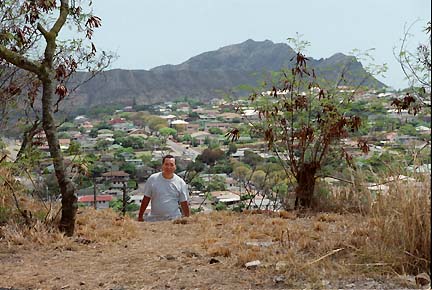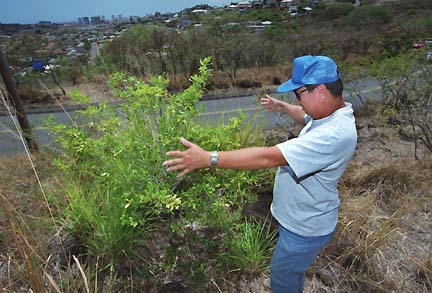Advertisement - Click to support our sponsors.


Native plants
find home in
upper Kaimuki
Mau'umae park habitat for
By Harold Morse
Hawaiian plants is made possible
by donations and volunteers
Star-BulletinMAU'UMAE Nature Park, a dryland restoration park in upper Kaimuki, has a guardian angel.
Plus, it has other volunteers who turned a once inhospitable area of kiawe and haole koa into a home for Hawaiian plants.
The guardian angel is Kaimuki Neighborhood Board member Leonard Tam, an original member of the Mau'umae Nature Park Committee.
After a recent board meeting, Tam explained the genesis of Mau'umae park, which owes everything to volunteer work and donated funds.
In 1991, after the state transferred ownership of the 33 acres to the city, the neighborhood board and community members decided to turn it into a nature park.

At that time, only one acre, at 16th Avenue and Claudine Street, had been cleared for a neighborhood mini-park, Tam said. That small park -- makai of where 16th Avenue turns into Koko Drive -- separates the makai four acres of Mau'umae Nature Park from its mauka 29 acres, he said.In place of the scrub brush, "We decided to reintroduce native plants into the area and also we built ... a loop trail within the 29 acres," Tam said. The loop trail provides access to the central area and also acts as a firebreak.
It took six months of volunteer work, beginning in February 1994, to build the trail, Tam said. "We had a core of five people, and we had some ladies from the Sierra Club that helped us. They did a lot of work." Boy Scouts, the Hawaii Trail and Mountain Club, the Hawaii Bicycling League and police volunteers also helped.
The trail was dedicated in August 1994.
"We've been planting some native species in there since then," Tam said, including kou, alahee, pohinahina, milo, ma'o, pa'uohi'iaka, akia, wiliwili and naio.

BUT the land is so hot and dry that it's taking time to get the plants started. Volunteers are experimenting with different procedures and have also installed a drip irrigation system that they're now working to expand.
Tam said some native plants were already growing in what became Mau'umae Nature Park when restoration started. Pili grass, 'a'ali'i, 'ilima and ala'ala wai nui were there, he said.
A huge brush fire in the 1970s consumed most of the 29-acre park mauka section and severely damaged or destroyed five homes, Tam said. That motivated volunteers to create the fire break. "In December 1994, right after we finished the trail, there was another fire, and the fire didn't cross the trail," Tam said.
"The Fire Department used the trail to get to the back side of the fire and fight it from both sides." The combination trail-firebreak worked, he said.
It's hoped the nature park eventually will become a botanical garden.
"We'll try to replicate the plants in the wild where we will not be irrigating the plants on a regular basis," Tam said.
Volunteers guide hikers through the park to show them the plants and geological formations and activity over time.
Meanwhile, Hui Ho'opili, a nonprofit organization within the city Department of Parks and Recreation, looks after donations.
"We have a pullout or lookout where people can pull over on Koko Drive and look at the back of Diamond Head and Puu-o-Kaimuki," Tam said. He explained that Puu-o-Kaimuki is a hill behind Kaimuki Fire Station that's also been turned into a park.

"You can also see portions of Kaimuki and Kahala," he said.In addition to the many volunteers, Tam credits original committee members still actively working at the park site for their contributions -- Toni Robinson, Al Rich and Joan Rich.
He says there's always a need for more volunteers and more donations. Those interested should call Robinson, with the parks department's East Honolulu District, at 973-7250.